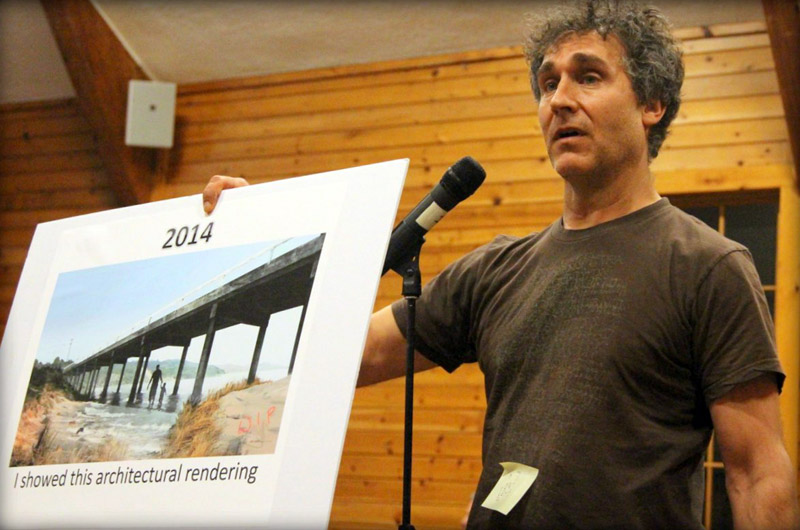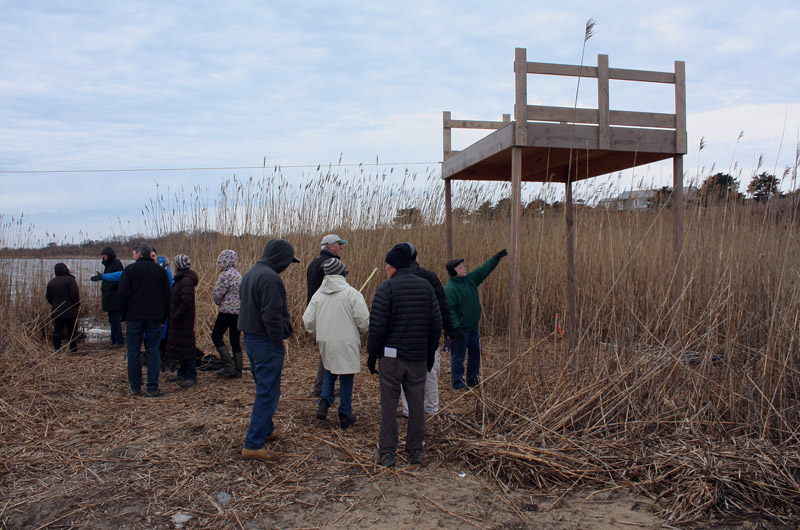A months-long public review and unanimous town vote last year have done little to pacify some Chilmark residents who still find fault in plans to restore Squibnocket Beach where a town parking lot and access road are threatened by erosion.
A large crowd turned out for a public hearing at the Chilmark Community Center Thursday night, where the Martha’s Vineyard Commission heard from engineers, town officials and concerned citizens.
The commission is deciding whether to review the plan — technically two plans — as a development of regional impact (DRI).
The project aims to relocate the town parking lot and build a raised causeway to Squibnocket Farm, a private home enclave at the beach. A manmade dune would be built and stone revetments removed at the site of the old parking lot, to allow the beach to naturalize.
On Thursday old arguments against the project reemerged, including from Charles Parker, who gave an exhaustive presentation criticizing the plan. The height of the causeway could be lowered, Mr. Parker said, and he challenged the 100-year storm criteria used by the engineering firm Haley and Aldrich to design the causeway.
The commission recently visited the site, where large wooden platforms showed the location and height of the proposed causeway, which runs through a wetland along Squibnocket Pond. Photographs of the platforms reappeared throughout the evening on a movie screen at the front of the room, where the Martha’s Vineyard Film Festival was held last week.
Approved by town voters last year, the beach restoration project is now in the permitting phase and was referred to the MVC by the Chilmark conservation commission in January.
New information Thursday included the results of a survey by Public Archaeology Lab of Pawtucket, R.I., which identified an ancient hand axe and other cultural remains likely associated with previously identified sites. The plans have been designed to avoid the archaeological resources.
Near the start of the hearing, selectman Warren Doty argued that the projects were unlike most DRIs. “This is not like someone who’s a chef proposing to open a new restaurant,” he said. “This is our proposal to fix something that is broken.
“We’ve been through three years of discussion about how to fix this broken part of the town of Chilmark.”
Jim Malkin, who chaired an exhaustive review of the project by a specially-appointed town committee last year, recounted the seven months of research and deliberation.
“We are happy that we received the support of the town,” he said.
But opponents, some of them abutters, vocally reiterated their concerns.

Doug Liman said the project had strayed from the committee’s draft recommendation when it comes to the height of the causeway. (The final recommendation did not specify a height.)
“This bridge seems to be very over-engineered — like a freeway, not a Chilmark road,” he said.
Thomas Bena disagreed with the concept of the project as a managed retreat, since solid structures are involved and some revetments would stay in place.
“These are all good people,” Mr. Bena said. “But if you ask an engineer for a solution, you get an engineered solution.” He urged the MVC to follow the advice of Vineyard Conservation Society, which has discouraged the use of hard structures at the site.
Early in the evening, Reid Silva who works for Vineyard Land Surveying, which designed the new parking lot, described the project as the first phase in a longer process that would unfold as the shoreline retreats.
Engineers for both projects have set a timetable for the next stage of retreat based on the distance of hard structures from the mean high-water level (40 feet for the turnaround and 10 feet for the ends of the causeway). But no one knows when that time will come. “If we had a Hurricane Sandy, that may happen in a year,” Mr. Silva said. “If you have a nice spell of calm weather, or no major hurricanes, then maybe 10 years.”
Chris Murphy, a member of the conservation commission who said he was taking off his hat as a town official to speak, backs the town part of the project, but not the homeowner association part.

“Squibnocket Farm’s plan for a steel and concrete bridge . . . is not exactly a poster child for managed retreat,” Mr. Murphy said. “This plan firmly places an immovable object in front of an unstoppable force.” He advocated for “a more ecologically sound plan,” that could set an example for the Island.
Commissioners occasionally sought further detail, or floated an alternative scenario, but most comments came from the floor.
Several people spoke in favor of the project, including Eric Peters, chairman of Vineyard Open Land Foundation, which has agreed to sell 1,500 feet of undeveloped beach property to the association, which in turn will lease it to the town for 99 years. Mr. Peters noted the high property values at Squibnocket Farm, and argued that the town and MVC had an obligation to help those landowners preserve their access.
“The town is trying to solve its own issue with respect to the parking lot and beach, which are rapidly becoming unusable,” Mr. Peters said.
The hearing was closed; written comments will be accepted until this coming Friday. A date has not been set yet for deliberations and a vote.






Comments
Comment policy »